Introduction
Physiotherapy in Hamilton West Mountain & Ancaster for Pain Care
Welcome to Westmount Physiotherapy’s guide to facet joint injections.
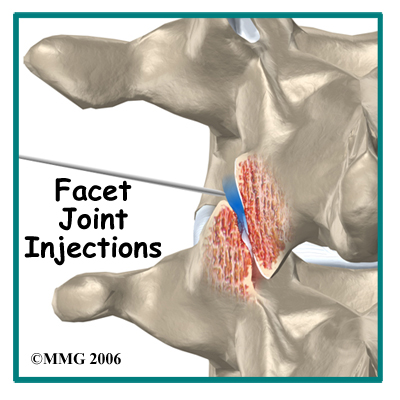 When dealing with a chronic painful spine condition pain specialists commonly use facet joint injections. These injections are primarily diagnostic injections, meaning that they help your doctor determine the cause of your back pain but they can also help to treat the painful condition, although they may not provide you with any long-term relief. Facet joint injections eliminate pain temporarily by filling the facet joint with an anesthetic medication that numbs the joint, the ligaments, and the joint capsule around the facet joint. If the facet joint is injected and your pain goes away for several hours, then it indicates to your doctor that it is very likely the joint or its closely related tissues that are causing your pain. Once you and your doctor know what structure is causing your pain, you can begin to explore options for treating the condition.
When dealing with a chronic painful spine condition pain specialists commonly use facet joint injections. These injections are primarily diagnostic injections, meaning that they help your doctor determine the cause of your back pain but they can also help to treat the painful condition, although they may not provide you with any long-term relief. Facet joint injections eliminate pain temporarily by filling the facet joint with an anesthetic medication that numbs the joint, the ligaments, and the joint capsule around the facet joint. If the facet joint is injected and your pain goes away for several hours, then it indicates to your doctor that it is very likely the joint or its closely related tissues that are causing your pain. Once you and your doctor know what structure is causing your pain, you can begin to explore options for treating the condition.
This guide will help you understand:
- where the injection is given
- what your doctor hopes to achieve
- what you need to do to prepare
- what you can expect from the injection
- what might go wrong
- what Westmount Physiotherapy’s approach to rehabilitation is
Anatomy
What parts of the body are involved?
A facet joint is a small, bony knob that extends out from the vertebral body. Where these knobs meet, they form a joint that connects the two vertebrae. The facet joints allow freedom of movement as you bend forward and back, and side to side.
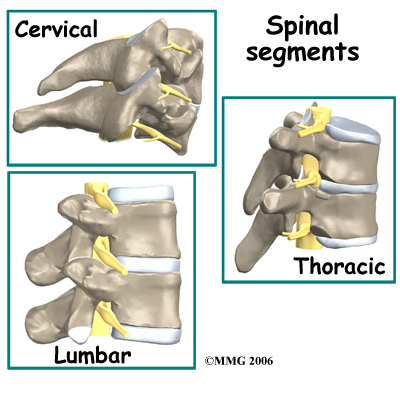 The surfaces of the facet joints are covered by articular cartilage. Articular cartilage is a smooth, rubbery material that covers the surface of all synovial joints. It allows the bone ends to move against each other smoothly without friction.
The surfaces of the facet joints are covered by articular cartilage. Articular cartilage is a smooth, rubbery material that covers the surface of all synovial joints. It allows the bone ends to move against each other smoothly without friction.
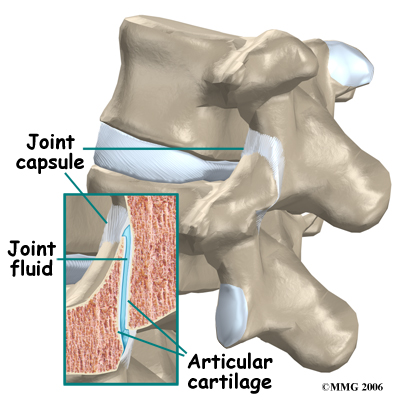
A joint capsule surrounds each joint. The joint capsule is made up of the ligaments and connective tissues that help hold the joint together. The joint capsule forms a watertight sac that contains the joint fluid.
There are two facet joints between each vertebrae of the spine. The facet joints are located at different angles in each of the cervical, thoracic and lumbar spines. This allows different movements to occur in each of these areas. Facet joint injections can be done in any of these areas of the back but the discussion here will focus mainly on those done for the lumbar spine.
Like all joints, the facet joints can wear out, or degenerate. This condition is sometimes called degenerative arthritis or osteoarthritis. When this occurs in the facet joints of the lumbar spine it can cause low back pain. In addition to back pain, the pain from degenerating facet joints in the lumbar spine may radiate into the buttock and back of the thigh.
Related Document: Westmount Physiotherapy's Guide to Lumbar Spine Anatomy
Rationale
What does my physician hope to achieve?
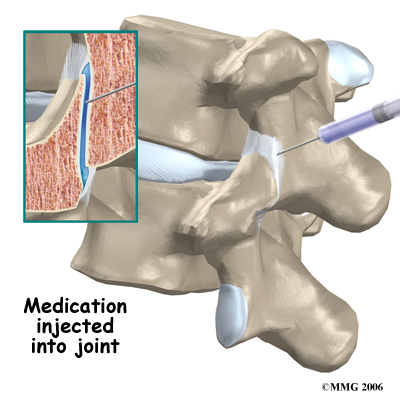 Your doctor is recommending a facet joint injection to try and determine if the joints are the cause of your back pain. As mentioned above, this type of injection is primarily a diagnostic injection. The injection may only reduce your pain temporarily; possibly only for a few hours. Once your doctor is sure that it is the facet joint causing your pain, other procedures may be recommended to reduce your pain for a longer period of time.
Your doctor is recommending a facet joint injection to try and determine if the joints are the cause of your back pain. As mentioned above, this type of injection is primarily a diagnostic injection. The injection may only reduce your pain temporarily; possibly only for a few hours. Once your doctor is sure that it is the facet joint causing your pain, other procedures may be recommended to reduce your pain for a longer period of time.
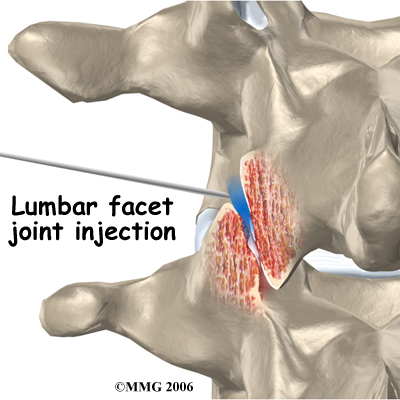
During a facet joint injection, the medications that are normally injected include a local anesthetic and cortisone. The anesthetic medication, such as lidocaine or bupivicaine, is the same medication used to numb an area when you are having dental work or having a laceration sutured. The medication causes temporary numbness lasting one hour to six hours, depending on which type of anesthetic is used.
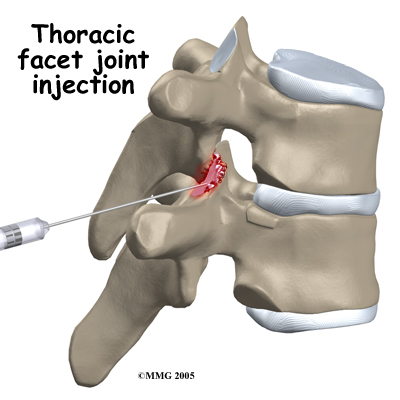 Cortisone is an extremely powerful anti-inflammatory medication. When this medication is injected into a painful, inflamed joint, it can reduce the inflammation and swelling. Reducing the inflammation reduces pain. If cortisone is also injected into the joint at the same time, you may get several weeks of relief from your pain. This period of pain relief can allow you to get started in or continue on with a physiotherapy program, strengthen the muscles, and begin to move normally again. In some cases when the cortisone wears off, the pain may not return.
Cortisone is an extremely powerful anti-inflammatory medication. When this medication is injected into a painful, inflamed joint, it can reduce the inflammation and swelling. Reducing the inflammation reduces pain. If cortisone is also injected into the joint at the same time, you may get several weeks of relief from your pain. This period of pain relief can allow you to get started in or continue on with a physiotherapy program, strengthen the muscles, and begin to move normally again. In some cases when the cortisone wears off, the pain may not return.
Related Document: Westmount Physiotherapy's Guide to Facet Joint Arthritis
Preparations
How will I prepare for the procedure?
To prepare for the procedure your doctor may tell you to remain "NPO" for a certain amount of time before the procedure. This means that you should not eat or drink anything for the specified amount of time before your procedure. This means no water, no coffee, and no tea. Nothing at all should be ingested. You may receive special instructions to take your usual medications with a small amount of water. Check with your doctor if you are unsure what to do.
You may be instructed to discontinue certain medications that affect the clotting of your blood several days before the injection. This reduces the risk of excessive bleeding during and after the injection. These medications may include the common Non-Steroidal Anti-Inflammatory Drugs (NSAIDs) such as aspirin, ibuprofen, naproxen, and many other medications that are commonly used to treat arthritis. If you are taking any type of blood thinning medication you should let your doctor know. You will most likely need to have this medication regulated or temporarily discontinued prior to the injection. Your doctor will need to determine if it is safe to discontinue these medications in order to have the injection.
You may need to arrange to have transportation both to and from the location where you will undergo the injection. Wear loose fitting clothing that is easy to take off and put on. You may wish to take a shower the morning of the procedure, using a bactericidal soap to reduce chances of infection. Do not wear jewelry or any type of scented oils or lotions.
Procedure
What happens during the procedure?
When you are ready to have the injection, you will be taken into the procedure area and an IV will be started. The IV allows the nurse or doctor to give you any medications that may be needed during the procedure. The IV is mainly for safety reasons as it allows a very rapid response to be carried out by the health care team if you have a problem during the procedure, such as an allergic reaction to any of the medications injected. In addition, if you are in pain or are very anxious, you may also be given medications through the IV for sedation during the procedure.
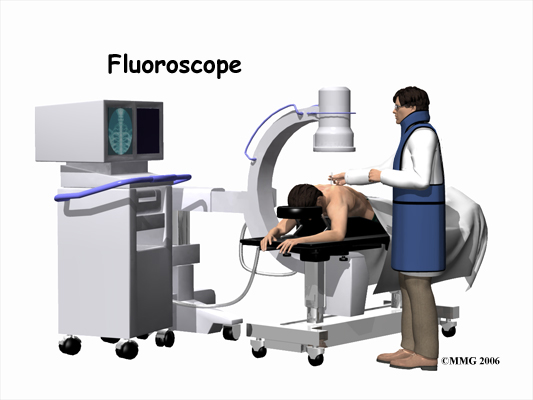 Most injection procedures today are done with the help of fluoroscopic guidance. The fluoroscope is an x-ray machine that allows the doctor to actually see an x-ray image while doing the procedure. This allows the doctor to watch where the needle goes as it is inserted and makes the injection much safer and more accurate.
Most injection procedures today are done with the help of fluoroscopic guidance. The fluoroscope is an x-ray machine that allows the doctor to actually see an x-ray image while doing the procedure. This allows the doctor to watch where the needle goes as it is inserted and makes the injection much safer and more accurate.
To perform a facet joint injection, your doctor inserts a needle into the facet joint so that the tip of the needle is inside the joint. Once the needle is in the right location, a small amount of radiographic dye is injected. This liquid dye shows up on the x-ray image and the doctor can watch where it goes. The medication used for the injection will go in the same place as the radiographic dye, so the doctor wants to make sure that the medication will go to the best place to do the most good. Once the correct position is confirmed, the medication is injected and the needle is removed.
Once the procedure is over you will be taken out of the procedure room to the recovery area. You will remain in the recovery area until the nurse is sure that you are stable and that you have not had any allergic reaction to the medications. The anesthetic may cause some temporary numbness and weakness. You will be free to go when these symptoms have resolved.
Complications
What might go wrong?
There are several complications that may occur during or after the facet joint injection. Injection procedures are safe and unlikely to result in a complication, but no procedure is 100% foolproof. This document doesn't provide a complete list of the possible complications, but it does highlight some of the most common problems. Complications are uncommon, but you should know what to watch for if they occur.
Like most procedures where medications are injected, there is always a risk of allergic reaction. The medications that are commonly injected include lidocaine, bupivicaine, radiographic dye, and cortisone. Allergic reactions can be as simple as developing hives or a rash. They can also be life threatening and restrict breathing. Most allergic reactions will happen immediately while you are in the procedure room so in these cases help is available immediately. Most reactions are treated and cause no permanent harm. You should alert your doctor if you have known allergies to any of these medications.
Several types of infections are possible complications of facet joint injections. Any time a needle is inserted through the skin, there is a possibility of infection. Before any injection is done, the skin is cleansed with a disinfectant and the health care provider doing the injection uses what is called a sterile technique. This means that the needle and the area where the needle is inserted remains untouched by anything that is not sterile. The provider may also use sterile gloves.
Infections can occur just underneath the skin, in a muscle, or in the facet joint. You should watch for signs of infection, which are increasing redness, swelling, pain, and fever. Almost all infections will need to be treated with antibiotics. If an abscess forms, then a surgical procedure may be necessary to drain the pus in the abscess. Antibiotics will also be necessary to treat the infection.
Many pain injections are done close to nerves. The facet joint injection is one of the safest spinal injections because the needle is usually not near the spinal nerves. Sometimes though the needle used to do the injection may accidentally hit a nerve. This can cause damage to the nerve and result in increased pain. Numbness and weakness may also result. Nerves that have been punctured with a needle will usually recover and do not require any additional surgical procedures.
Not all injections work as expected. Sometimes, injections cause more pain. This may be due to increased spasm in the muscles around the injection. The increased pain is usually temporary, lasting a few hours or a few days. Once the medication has a chance to work, the injection may actually perform as expected and reduce your pain. Increased pain that begins several days after the injection may be a sign of infection. You should alert your doctor if this occurs.
After Care
What happens after the procedure?
You will be able to go home soon after the procedure, probably within one hour. If all went as planned, you probably won't have any restrictions on activity or diet. If you have already been doing physiotherapy at Westmount Physiotherapy you should return to therapy as soon as it is feasible. Physiotherapy treatment is beneficial after the injection because the potential short period of pain relief received from the injection often provides a valuable window of time. This time can allow you to more effectively do your physiotherapy exercises and possibly more permanently decrease your overall pain levels as well as improve the way you move. If you have not done any physiotherapy yet for your back pain prior to the injection then you should begin treatment at Westmount Physiotherapy as soon as you can after the injection.
Both your doctor and physiotherapist will be interested in how much the pain is reduced while the anesthetic (numbing medication) is working. You may be given a pain diary to record what you feel for several hours after the injection. This is important for making decisions about treatment, so keep good track of your pain levels. You may find it easiest to regularly grade your pain in the pain diary from zero to ten with zero being no pain at all and ten being the worst pain you have ever felt.
Most doctors will arrange a follow-up appointment, or phone consult, within one or two weeks after the injection to see how you are doing and what the effect of the procedure was on your symptoms.
One question that always comes up is: How many injections are safe to have? There is no definite answer to that question. Most doctors would recommend that you limit the number of injections to three to five per year. The reason for this limit has to do with how much cortisone is safe to put in your body. Cortisone has bad side effects when you take the medication often, either as a pill or as an injection. These side effects are why doctors do not like to do these injections more often than necessary.
Rehabilitation
Physiotherapy at Westmount Physiotherapy can be very useful for patients with back pain both before having a facet joint injection as well as afterwards. After having an injection there may be a short window of time where you have some relief from your pain and this window often allows you to more effectively rehabilitate your back and improve your overall movements. This may in turn decrease your symptoms long term.
Generally it is not recommended to treat any pain you have that is directly related to the injection itself for at least a few days. The injection is done specifically to determine how your back reacts to the injected substances, so waiting and watching to see if there is discomfort or relief specifically from the injection is the best approach at first. If, however, you have ongoing pain from the injection itself that lasts longer than would be expected, or your original pain returns after the injection your physiotherapist can treat this pain. They may use heat, ice, or electrical modalities such as ultrasound or interferential current to help decrease your pain. They may also massage around your back, buttocks, and hip areas to provide relief by relaxing tight muscles that could be pulling on the joints of the back. In addition, while working to calm your back pain your physiotherapist will ask you to limit or modify any activities that irritate your back. A short period of resting from aggravating activities can be very useful along with physiotherapy treatment in reducing any acute irritation.
In order to know how best to treat your individual back problem, your physiotherapist will assess your back and will determine how well your back is moving. If it is determined that the movement of the facet joints in your back is limited, encouraging more motion can help to ease your pain. Your physiotherapist has several methods to help increase the motion in your back. These methods may include using joint mobilizations or manipulations, performing passive stretching, and massaging any tight muscles related to the area. Stretches and strengthening exercises as part of a home program will also be prescribed as they can help you gain more motion in your back, as well as improve the strength and endurance of the muscles that help to support your back. These exercises may be targeted at your low back directly, but will also include exercises for your abdominals and trunk (core) area, buttocks and hips, groin, and the front and back of your thighs.
Maintaining a strong core muscle area is the most crucial part of managing your back pain and allowing you to maintain as active of a lifestyle as you can despite any chronic pain. Your physiotherapist can teach you how to properly activate the core muscles and build up their strength and endurance. Even just simple exercises such as gently tightening the muscles of your deep abdominal area directly after you have received your injection will help to support the back. If your therapist has deemed your back to be relatively moving too much, then the core exercises are even more crucial. Stretching exercises that target the tight muscles, which may be pulling the back into an adverse position, will also be prescribed. As you improve your activation, strength, and endurance of your core muscles, more advanced exercises will be prescribed in order to challenge the ability of these muscles and ensure they can stabilize the spine during everyday functional activities.
Another area particularly important in helping to support your back is your hip/buttocks (gluteal) area. Your therapist will assess both the range of motion of your hips as well as the ability of your gluteal muscles to support the hips and back. If your hip range of motion is poor or your gluteals are not strong enough then extra stress is transferred to your low back. Again, often that short window where you may have less pain after your facet joint injection is a time when you can more effectively strengthen your buttocks muscles. The flexibility of the anterior hip muscles as well as the muscles of the front and back of your thigh will also be assessed and stretches may be provided if any of these muscles are found to be tight or overactive.
Doing your prescribed exercises in a hydrotherapy pool may be a useful option for you that you can discuss with your therapist. Often the warmth of the pool and the hydrostatic properties of the water can make range or motion, strengthening, and overall retraining of muscular control easier.
As with any injury or biomechanical dysfunction, maintaining one’s posture and alignment is very important. Despite whether your physiotherapist determines that your low back has increased or decreased motion, they will be strict in encouraging you to maintain proper posturing and alignment at all times. Maintaining good posture can significantly decrease the stress put through the back. Any window of time that you have which is pain-free after your injection can also be particularly useful in re-training your body to maintain proper alignment. By improving the endurance of the muscles that support your back, you will be able to maintain your posture and alignment for longer periods of time, and lengthen the time frame between painful flare-ups.
In addition to your posture your gait will also be reviewed. Pain not only affects your static posture but can also cause you to develop an inefficient walking pattern that puts unnecessary stress on joints in the lower extremities and the back. In a normal day most people take thousands of steps just to get around, therefore an inefficient or improper walking pattern can quickly lead to pain either in the back itself or other related joints. Your physiotherapist will assess your gait and ensure that you are walking properly.
Your physiotherapist may also suggest the use of tape or a back brace in order to help manage your back pain. Tape can be a useful method to assist the muscles to support your back. A brace can help to support your back long-term particularly during prolonged static or active periods. Sometimes a trial of tape before an expensive brace is purchased is a good method of determining the potential use of a brace. Your physiotherapist can discuss whether or not they feel a brace would be useful in your individual case.
Once your back pain is under control your therapist will discuss the importance of a cardiovascular program to assist in managing your back pain long-term. At Westmount Physiotherapy we believe that maintaining your overall fitness level is an effective method in helping to manage both the pain and stress that comes with chronic pain and is a way to help decrease the number of flare-ups of your injury that occur. Your therapist can discuss with you the best cardiovascular activity options that would be appropriate in your individual case. Often cycling, water aerobics or water running, or other low impact activities are the most appropriate ones to try particularly after a facet joint injection.
Generally the treatment we provide at Westmount Physiotherapy for your back after a facet joint injection can assist greatly in managing your back pain but it should be remembered that these injections are not generally a cure for your chronic pain; they are only a part of your overall pain management plan. You will need to continue working long- term with your doctor, physiotherapist, and any other health care professional involved in your pain management. You will also need to continue faithfully doing your rehabilitation home program in order to best manage your back pain. If your pain is ongoing despite the injection and regular physiotherapy treatment your doctor may want to discuss with you the possibility of another injection or other more aggressive pain management options.
Portions of this document copyright MMG, LLC.
Westmount Physiotherapy provides services for physiotherapy in Hamilton West Mountain & Ancaster.
 When dealing with a chronic painful spine condition pain specialists commonly use facet joint injections. These injections are primarily diagnostic injections, meaning that they help your doctor determine the cause of your back pain but they can also help to treat the painful condition, although they may not provide you with any long-term relief. Facet joint injections eliminate pain temporarily by filling the facet joint with an anesthetic medication that numbs the joint, the ligaments, and the joint capsule around the facet joint. If the facet joint is injected and your pain goes away for several hours, then it indicates to your doctor that it is very likely the joint or its closely related tissues that are causing your pain. Once you and your doctor know what structure is causing your pain, you can begin to explore options for treating the condition.
When dealing with a chronic painful spine condition pain specialists commonly use facet joint injections. These injections are primarily diagnostic injections, meaning that they help your doctor determine the cause of your back pain but they can also help to treat the painful condition, although they may not provide you with any long-term relief. Facet joint injections eliminate pain temporarily by filling the facet joint with an anesthetic medication that numbs the joint, the ligaments, and the joint capsule around the facet joint. If the facet joint is injected and your pain goes away for several hours, then it indicates to your doctor that it is very likely the joint or its closely related tissues that are causing your pain. Once you and your doctor know what structure is causing your pain, you can begin to explore options for treating the condition.








 The surfaces of the facet joints are covered by articular cartilage. Articular cartilage is a smooth, rubbery material that covers the surface of all synovial joints. It allows the bone ends to move against each other smoothly without friction.
The surfaces of the facet joints are covered by articular cartilage. Articular cartilage is a smooth, rubbery material that covers the surface of all synovial joints. It allows the bone ends to move against each other smoothly without friction.
 Your doctor is recommending a facet joint injection to try and determine if the joints are the cause of your back pain. As mentioned above, this type of injection is primarily a diagnostic injection. The injection may only reduce your pain temporarily; possibly only for a few hours. Once your doctor is sure that it is the facet joint causing your pain, other procedures may be recommended to reduce your pain for a longer period of time.
Your doctor is recommending a facet joint injection to try and determine if the joints are the cause of your back pain. As mentioned above, this type of injection is primarily a diagnostic injection. The injection may only reduce your pain temporarily; possibly only for a few hours. Once your doctor is sure that it is the facet joint causing your pain, other procedures may be recommended to reduce your pain for a longer period of time.
 Cortisone is an extremely powerful anti-inflammatory medication. When this medication is injected into a painful, inflamed joint, it can reduce the inflammation and swelling. Reducing the inflammation reduces pain. If cortisone is also injected into the joint at the same time, you may get several weeks of relief from your pain. This period of pain relief can allow you to get started in or continue on with a physiotherapy program, strengthen the muscles, and begin to move normally again. In some cases when the cortisone wears off, the pain may not return.
Cortisone is an extremely powerful anti-inflammatory medication. When this medication is injected into a painful, inflamed joint, it can reduce the inflammation and swelling. Reducing the inflammation reduces pain. If cortisone is also injected into the joint at the same time, you may get several weeks of relief from your pain. This period of pain relief can allow you to get started in or continue on with a physiotherapy program, strengthen the muscles, and begin to move normally again. In some cases when the cortisone wears off, the pain may not return. Most injection procedures today are done with the help of fluoroscopic guidance. The fluoroscope is an x-ray machine that allows the doctor to actually see an x-ray image while doing the procedure. This allows the doctor to watch where the needle goes as it is inserted and makes the injection much safer and more accurate.
Most injection procedures today are done with the help of fluoroscopic guidance. The fluoroscope is an x-ray machine that allows the doctor to actually see an x-ray image while doing the procedure. This allows the doctor to watch where the needle goes as it is inserted and makes the injection much safer and more accurate. 
